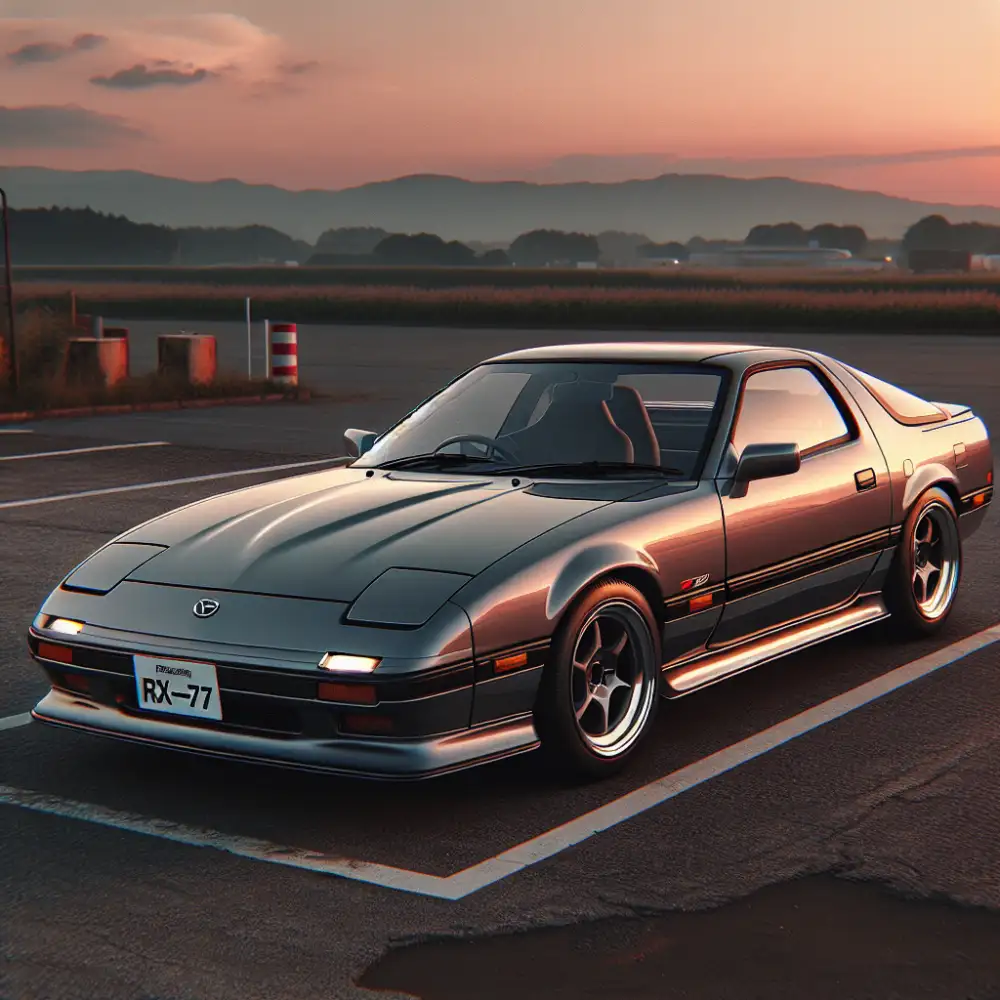1987 RX7: A Legend Turns 35

Design and Styling
The 1987 Mazda RX-7, a true icon of the 1980s, boasted a design that was both elegant and aggressive. Its low-slung, wedge-shaped profile, a hallmark of sports car design during that era, exuded a sense of speed even when standing still. The pop-up headlights, a coveted feature in the 1980s, further enhanced its sleek aesthetic, giving it a clean and aerodynamic front end when not in use.
Complementing the RX-7's low profile was a set of wide, flared wheel arches that housed stylish alloy wheels. These arches not only contributed to the car's muscular stance but also hinted at the performance capabilities hidden beneath its skin. The wraparound rear window, a distinctive design element, provided excellent visibility while adding to the car's sporty appeal.
Inside, the 1987 Mazda RX-7 offered a driver-focused cockpit. The dashboard, angled towards the driver, featured clear and concise instrumentation, putting all the vital controls within easy reach. The bolstered sport seats provided excellent support during spirited driving, while the small-diameter, three-spoke steering wheel offered optimal control and feel.
Overall, the 1987 Mazda RX-7's design was a harmonious blend of sporty aesthetics and functional aerodynamics. It was a car that looked fast even when standing still, and its timeless design continues to captivate automotive enthusiasts even today.
Engine and Performance
The 1987 Mazda RX-7, a car that truly embodies the phrase "sports car," is powered by a unique and potent engine. Its heart is a 1.3-liter twin-rotor Wankel rotary engine. This engine, known for its smooth power delivery and high-revving nature, produces an impressive 146 horsepower. The 1987 RX-7 could go from 0 to 60 mph in just over eight seconds. This may not seem groundbreaking by today's standards, but it was quite respectable for its time.
The engine's power is sent to the rear wheels through a five-speed manual transmission. This setup ensures an engaging driving experience, allowing drivers to truly connect with the car. The 1987 RX-7 is not just about straight-line speed; it's about the overall driving experience. The car's lightweight design, coupled with its responsive handling, makes it an absolute joy to drive on winding roads.
The 1987 RX-7 wasn't just about performance; it was also surprisingly fuel-efficient for a sports car of its era. It could achieve an average of 18 mpg in the city and 23 mpg on the highway, which were respectable figures for the time.
However, the rotary engine does have its quirks. It's known to consume a bit more oil and fuel compared to traditional piston engines. But for enthusiasts, these are small prices to pay for the unique character and driving experience that the rotary engine provides.
Handling and Driving
The 1987 Mazda RX-7, specifically the second-generation FC model, is lauded for its handling prowess. It’s a front-engine, rear-wheel-drive sports car with a near-perfect weight distribution, contributing to its agile and responsive nature.

The car's suspension setup, featuring independent struts in the front and a live axle with Watt's linkage in the rear, is tuned for a balance of comfort and sportiness. This allows the RX-7 to navigate corners with minimal body roll while maintaining a comfortable ride.
Powering the 1987 RX-7 is a 1.3-liter rotary engine, known for its smooth power delivery and high redline. This engine, paired with the car's lightweight design, makes the RX-7 remarkably quick and nimble.
The steering is precise and communicative, providing ample feedback to the driver. This, combined with the car's balanced handling and responsive throttle, makes for an engaging and rewarding driving experience.
However, the RX-7's light rear end can be prone to oversteer, especially in wet or slippery conditions. This characteristic, while exhilarating for experienced drivers, requires caution and a measured approach.
Overall, the 1987 Mazda RX-7 offers a thrilling driving experience thanks to its exceptional handling, balanced performance, and communicative steering. It's a car that rewards skilled drivers and provides pure driving enjoyment.
Interior and Features
The 1987 Mazda RX-7 embraced a driver-focused philosophy. The cabin was ergonomically designed with a distinct wraparound dashboard angled towards the driver. This layout provided intuitive access to the controls and gauges. Speaking of gauges, the RX-7 boasted a sporty instrument cluster featuring a large tachometer and speedometer, along with gauges for oil pressure, water temperature, and fuel level.
Mazda offered the 1987 RX-7 in two main trims: the base model and the GXL. Cloth upholstery came standard, but leather was an available option on the GXL. The sport seats provided excellent support during spirited driving, a testament to the car's performance intentions.
Despite its compact size, the RX-7 didn't skimp on features for 1987. Power windows and door locks were standard, as was an AM/FM stereo. For those seeking a more premium audio experience, a cassette player and even a graphic equalizer were available as optional extras. Air conditioning was also an option, providing welcome relief on hot days.
While not known for its cargo space, the 1987 RX-7 offered a surprisingly usable rear hatch area. The rear seats could even be folded down to accommodate larger items. Overall, the interior of the 1987 Mazda RX-7 offered a compelling blend of sportiness, comfort, and features, making it a joy to drive on both winding roads and daily commutes.
| Feature | Details |
|---|---|
| Engine | 1.3L Rotary (13B) |
| Horsepower | 146 hp @ 6500 rpm |
| Transmission | 5-speed manual, 4-speed automatic (optional) |
| 0-60 mph | 8.0 seconds (approx., manual) |
| Body Style | 2-door coupe |
Legacy and Impact
The 1987 Mazda RX-7 FC3S, while not the first iteration of the model, solidified its place as a true icon in the automotive world. Its sleek, updated design, heavily inspired by the Porsche 944, turned heads and challenged the common perception of affordable sports cars. The 1987 model year brought with it significant improvements, including a revised suspension tuning and the option for larger 4-piston brake calipers on the Turbo II model, further enhancing its handling capabilities.

But the heart of the RX-7, and what truly set it apart, was its unique powerplant. The rotary engine, with its compact size, high-revving nature, and smooth power delivery, became synonymous with the RX-7. This engine, while demanding more frequent maintenance, offered a driving experience unlike anything else on the road.
The impact of the second-generation RX-7, particularly the 1987 model, is undeniable. It proved that performance and affordability weren't mutually exclusive, inspiring a generation of enthusiasts and solidifying Mazda's reputation for building driver-focused cars. Its influence can still be seen today in the design language of modern sports cars and the enduring fascination with the unique characteristics of the rotary engine. The 1987 RX-7 wasn't just a car; it was a statement. It declared that driving joy could be accessible, and it cemented its place as a true legend of the road.
Published: 25. 06. 2024
Category: Food



